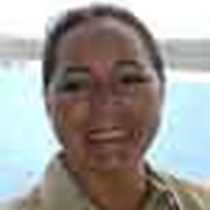Floreana Island
The island of Floreana is a real mystery island. Tales of disappearances, murder and famous (or rather infamous) visitors are told; this island has seen it all. We started the day with a short stroll to the Post Office Barrel, which the bay is named after. A whaling captain came up with this great idea of how to get mail home. They would leave letters in the barrel and a future visitor would take them across the globe to deliver. No stamps were involved, and these days sometimes the mail gets home faster than the regular Ecuadorian mail service could accomplish! Our group posted several postcards today, and some of us also picked up something to deliver. This short but historically interesting visit was topped off with a spectacular panga ride among the small islands of the “Loberia.”
While we breakfasted, we sailed towards Champion Island. Along the way, we spotted two Bryde’s whales. To our delight, a small whale (about 30 feet in length) began playing with us and spent 20 minutes bow riding. This is very unusual behavior! Among all our Natural History staff and with our many years in Galápagos, none of us have even heard of this behavior before!
The snorkeling at Champion was fabulous; there were huge numbers of schooling fish and many playful sea lions. On Zodiac rides around the island we observed the rare and endemic Floreana mocking bird. After our buffet lunch and siesta we had another chance to snorkel around Devil’s Crown or spend some leisurely time on a small and deserted beach at Punta Cormorant.
The afternoon walk started at 4:00 p.m. from the so-called green beach. The sand is rich in olivine crystals and from these it gets its greenish-brown color. In a large lagoon directly behind the landing beach we found several flamingos. A pale pinkish gray juvenile that was quite close to us provided great photo opportunities. The visit to Punta Cormorant is considered a must for botanists. Along the trail the naturalists identified several species of plants that only grow here. These are mostly plants in the Asteraceae family that have adapted to the local environment, and no longer closely resemble their ancestors that arrived to Galápagos many hundreds of years ago.
The trail descended to a lovely white beach, a favorite nesting site for sea turtles during their breeding season. This is a beautiful and most peaceful location, and we strolled here for a while. As we returned to the MS Islander at the end of the day, we said farewell to one of the more scenic islands of the Galápagos.
The island of Floreana is a real mystery island. Tales of disappearances, murder and famous (or rather infamous) visitors are told; this island has seen it all. We started the day with a short stroll to the Post Office Barrel, which the bay is named after. A whaling captain came up with this great idea of how to get mail home. They would leave letters in the barrel and a future visitor would take them across the globe to deliver. No stamps were involved, and these days sometimes the mail gets home faster than the regular Ecuadorian mail service could accomplish! Our group posted several postcards today, and some of us also picked up something to deliver. This short but historically interesting visit was topped off with a spectacular panga ride among the small islands of the “Loberia.”
While we breakfasted, we sailed towards Champion Island. Along the way, we spotted two Bryde’s whales. To our delight, a small whale (about 30 feet in length) began playing with us and spent 20 minutes bow riding. This is very unusual behavior! Among all our Natural History staff and with our many years in Galápagos, none of us have even heard of this behavior before!
The snorkeling at Champion was fabulous; there were huge numbers of schooling fish and many playful sea lions. On Zodiac rides around the island we observed the rare and endemic Floreana mocking bird. After our buffet lunch and siesta we had another chance to snorkel around Devil’s Crown or spend some leisurely time on a small and deserted beach at Punta Cormorant.
The afternoon walk started at 4:00 p.m. from the so-called green beach. The sand is rich in olivine crystals and from these it gets its greenish-brown color. In a large lagoon directly behind the landing beach we found several flamingos. A pale pinkish gray juvenile that was quite close to us provided great photo opportunities. The visit to Punta Cormorant is considered a must for botanists. Along the trail the naturalists identified several species of plants that only grow here. These are mostly plants in the Asteraceae family that have adapted to the local environment, and no longer closely resemble their ancestors that arrived to Galápagos many hundreds of years ago.
The trail descended to a lovely white beach, a favorite nesting site for sea turtles during their breeding season. This is a beautiful and most peaceful location, and we strolled here for a while. As we returned to the MS Islander at the end of the day, we said farewell to one of the more scenic islands of the Galápagos.




